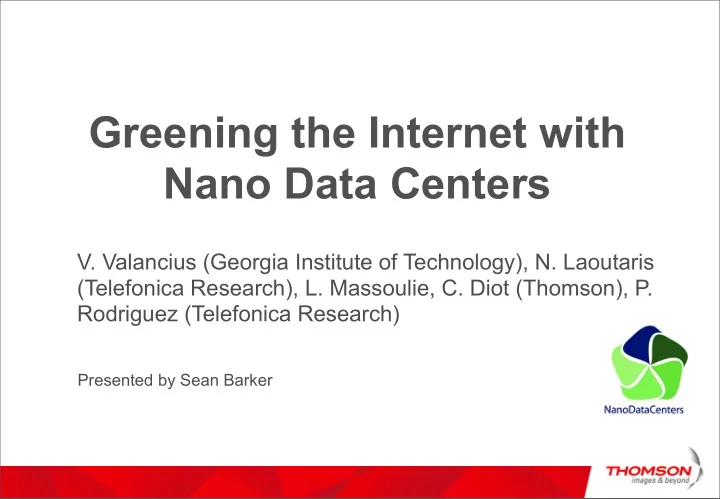

Greening the Internet with Nano Data Centers V. Valancius (Georgia Institute of Technology), N. Laoutaris (Telefonica Research), L. Massoulie, C. Diot (Thomson), P. Rodriguez (Telefonica Research) Presented by Sean Barker
Gateway vs. Set-top-box Home gateway • Internet connection • Tra ffj c management Internet Set-top-boxes • Content processing 2
Gateway as new center of media experience Content & Control Servers Internet services The Internet Home network Extended home network 3
The current model: Data centers Data Centers The Internet Home boxes . . . DSLAM 4
Limitations Expensive – High capital investment – Customer generally pays per byte Location constraints in order to be “central” Requires a lot of redundancy to be robust – Electricity shortage – Content availability Power, power, power New service deployment is slow – ISPs not encouraged to take risks, nor to deploy new services 5
The nano data center Take advantage of always-on gateways Add memory and stronger CPU to home gateways Push content to gateways when bandwidth is cheap Manage millions of gateways as a logical ‘single server’ using P2P infrastructure 6
The nano data center model Control Video server server Home boxes The Internet . . DSLAM . 7
The nano data center PROS CONS – – Uplink bandwidth often limited Multiple applications can take advantage of the model (VoD, – Millions of boxes to manage using P2P gaming, catchTV, UGC) – Cost of gateway – ISP friendly – Incentive? – Reduces traffic volumes and – Privacy? variability on backbones. – Always on? – Highly scalable and robust by design – Cheap for ISPs – Flexible for users – Localized & personalized services 8
Gateway uptime (*) More than 60% of gateways are up more than 80% of the time (*) Courtesy of Krishna Gummadi 9
Push phase Control Video server content server RHGs . . DSLAM . 10
Pull phase Control Video server content server RHGs . . DSLAM . 11
Placement strategy Data window … Movie … … … 3 … 1 2 3 K 1 2 3 K 1 2 K … … … … Erasure codes 1 2 3 M 1 2 3 M 1 2 3 M (e.g., LDPC) 11… 1 … … M…M 22 2 33 3 M … gateways 12
Placement strategy Replicate content according to popularity Popular content served by gateways – slack bandwidth from original content servers Number of replicas determined by solving optimization problem – Constraints on available upload and storage, number of clients, request rates, etc. 13
Popularity aware placement Partition content into hot / warm / cold categories • Hot: replicate on all gateways • Warm: use code-based placement • Cold: no proactive placement (stays on servers) popularity hot warm cold movies b/w memory 14
Data Centers: Where should NaDa save energy? capital cost, redundancy, cooling Free ride on Data always-on Centers Gateways The Internet Home boxes . Internet: less . hops, less . DSLAM bandwidth 15
Energy issues Variables – Network topology – Hardware power consumption – Placement algorithms – Content popularity – User behavior Data available – DSL gateways and VoD servers power (Thomson) – Routers power (Cisco data) – Telefonica Spain and Peru network topologies – Imagenio VoD platform (Telefonica Spain) – Telefonica IPTV – Netflix movie popularity 16
VoD server power α s = 4% 17
Gateway power α g = 1% 18
When would NaDa not work ? power Gateways Server Baseline power # bytes transferred 19
When does NaDa work ? power Server Baseline power Gateway s N # bytes transferred 20
Trace driven simulations Traces from – Netflix, IPTV (Telefonica), YouTube Content popularity from Netflix Topologies and workload from Telefonica Power numbers from Thomson’s gateway and IPTV servers Popularity aware placement 21
Simulation parameters Gateway Storage 100MB-10GB Gateway Upstream 0.1-2Mbps Content characteristics from data set Users 10k-30k Content window 10s-120s Replicas for warm content 1 (20s windows) Simulation duration 1 day - 86400 s Router energy/bit 150 10 − 9 Server energy/bit 40 10 − 9 Gateway energy/bit 18 10 − 9 Power Usage Effectiveness (PUE) 1.7 Home electricity cost factor 1.1 Hops to server 4 Hops to peer 2 22
Total energy use (YouTube) 60k 50k 40k 30k 20k 10k 23
Gateway storage 5000 4500 4000 3500 3000 2500 500 1,000 1,500 2,000 2,500 3,000 24
Number of users 5500 5000 4500 4000 3500 3000 2500 15,000 20,000 25,000 30,000 Number of users 25
Upstream bandwidth Video streaming > 5000 uplink rate Video streaming 4500 < uplink rate 4000 3500 3000 0.2 0.4 0.6 0.8 1.0 1.2 26
Conclusions Free-riding on existing infrastructure can significantly reduce load on conventional servers Simulations demonstrated energy savings ranging from 20% to 60% versus data centers Gateways can accomplish this with only modest resources (a few GB of storage, limited upload) 27
Questions? Potential QoS issues moving control from content providers (YouTube) to ISPs Effects of consumer line overprovisioning Security of content serving from home gateways 28
Recommend
More recommend